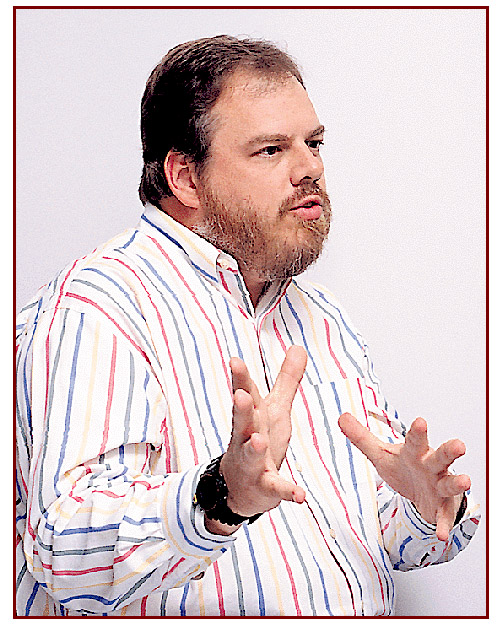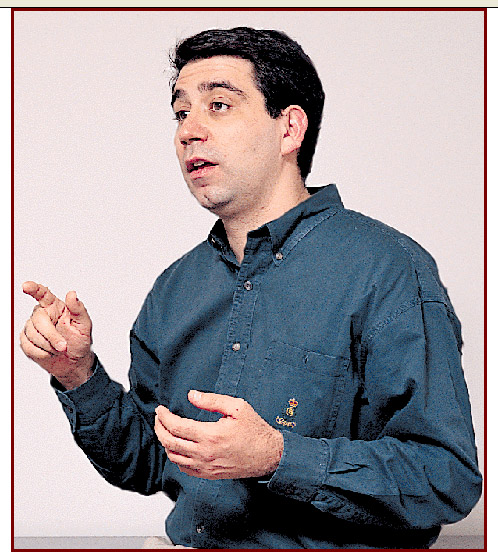| Unix (Steve MacKay, vice president, Solaris products
group at SunSoft) faces off against Windows NT (Mike Nash,
group product manager for Windows NT Server) BYTE (to SunSoft): Why do you think Solaris Unix is better than Windows NT? MACKAY: Scalability, reliability, and performance. Solaris has demonstrated linear scalability to 64 processors in a system, has databases larger than 5 terabytes, and lets thousands of users connect. NT does not come close. Solaris systems stay on-line for months, handling transaction after transaction. This defines mission-critical enterprise and Internet computing. And that is why the largest relational databases run on Solaris, not on NT. In recent database performance benchmark testing (TPC-C) on a Compaq Proliant 4500, Solaris with Oracle7 outperformed NT with SQL Server by 30 percent. It takes a lot of NT marketing to overcome objective results such as this. NASH: In the TPC-C tests, the difference is only about 5 percent. In normal operating modes, with acceptable transaction times, equal Unix and NT systems deliver roughly equal performance. Microsoft SQL Server has a limitation of 4 TB, but a 4-TB database would give you slower response time on any system. NT has structured exception handling for capturing error conditions and responding to them uniformly. The file system is designed to recover from all types of disk errors [and is] protected by a U.S. government-certified C2 security architecture. When performance, scalability, and reliability are comparable, the important issues are service, support, and cost of administration and maintenance. NT Server provides huge savings in these areas. NT Server is the only OS that delivers the same API set, user interface, and administration model on Intel, Mips, Alpha, and PowerPC processors. Customers [can] deploy whatever hardware is appropriate at any time. With Unix, you get locked into a particular vendor's Unix variant. BYTE (to Microsoft): Why do you think NT Server is better than Unix? NASH: NT Server is the only true multipurpose OS. It combines the performance of file and print servers and the power of Unix application servers with the ease of use of Windows. A single cross-platform API lets developers write code once and target many platforms. Users benefit from the easy-to-use Windows environment. Administrators [can] learn, use, and manage one system with powerful file and print services plus robust and reliable applications services. NT Server is interoperable with other systems such as NetWare; it integrates with legacy systems while offering a smooth migration. And NT Server supports up to 32 processors. MACKAY: This discussion is not about NT versus the various versions of Unix, but about Solaris and NT. If the network is the computer, then we're talking about what it will take in this new paradigm: computing on the Internet. Microsoft's story holds together as long as the picture is monolithic: Windows dominates the desktop, NT is the application server, and everything is tied together with OLE. This isn't modular, flexible, or easily customizable. Application code to update could be on thousands of desktops, leading to high administration costs. NT does not have the reliability and scalability required to run business-critical applications on networked servers that may have hundreds of thousands of users hitting on it every day, which is where we are with Internet-based applications. SunSoft's vision of the user world presumes a modular, distributed client/server environment, where mission-critical databases are on mainframes or large application servers, and clients can be anywhere, running on anything. In this model, the GUI interface decouples from the business logic, which in turn decouples from the database. In a traditional client/server environment, the application resides on thousands of desktops, every one of which has to be updated. Administration costs are high. But not for the SunSoft model, because the code resides in one place. BYTE (to SunSoft): Where do you see Unix in five years, in market presence and technology? MACKAY: Solaris is driving the future of Unix, including databases, Internet servers, communication servers, and how people organize and run their businesses. Microsoft has missed the Internet wave, so its growth will be limited. The key technologies will be scalability, support for standards, object technology, and directory services. With Solaris, we already deliver on these technologies, and we will continue to invest in these areas in the future. NASH: Microsoft has certainly not missed the Internet wave. We are likely to create the next major surge with Internet Information Server (IIS). With NT Server and IIS, we are offering a high-speed server that is simpler to own and operate than anything from Sun. By contrast, the licensing, training, maintenance, and support costs to run a Unix Internet solution are prohibitive. In a 1995 IDC article, Starwave comments that "an Internet infrastructure similar to a current Unix installation using NT servers and software could save at least $60,000 on hardware and several thousand dollars on software licensing." BYTE (to Microsoft): Where do you see NT in five years, in market presence and technology? NASH: Today's customers are using NT Server in Unix environments. They will migrate applications to NT Server because NT will offer leading-edge technology, such as Network OLE and seamless integration with Windows. NT will evolve to support new hardware platforms. NT Server will offer more sophisticated support for building distributed applications with Network OLE. NT Server will offer integrated namespaces to enable users to access resources regardless of the repository. As a first step, the upcoming version of NT will provide native support for DNS. A later version will include a more hierarchical, flexible directory that is upward-compatible with the current NT directory service. Through ODSI [Open Directory Service Interface], these namespaces — including Street Talk and NetWare Directory Services — will be integrated and accessible by users as one namespace. Developers will benefit from writing to one API (ODSI) to create applications that take advantage of this multidirectory namespace. MACKAY: Today, Solaris uptime is measured in months, not days. Today, Solaris incorporates such industry standards as CORBA, which facilitates scalable, language-independent, network computing. Today, we support XFN [X/Open Federated Naming], which facilitates universal access to various directory naming services. Today, the networked objects and management technologies of Neo and Solstice are tightly integrated with Solaris. An Internet server OS must be able to grow. Over the next two years, Solaris will be extended to support a file system of nine million TB. It will also have a 64-bit kernel, addressing, networking, and asynchronous I/O. Yet, 64-bit Solaris will maintain compatibility with existing 32-bit applications and data sets. BYTE (to SunSoft): What will be the important new features of the next major Solaris release? MACKAY: A network-oriented object model for Solaris. Neo — SunSoft's networked object environment technology based on CORBA — is already available. Many use it as their foundation for rapidly deployed enterprise applications. When Neo is paired with Sun's Java, the result is powerful, distributed applications that can bring global resources together to create the information needed to drive critical business processes. Think of Neo plus Java as programming the network, where truly the network is the computer. One major innovation for systems software will be the move to 64-bit systems. Already there are full 64-bit microprocessors entering mainstream use; for example, the UltraSparc. These 64-bit systems will bring new scalability and performance to classes of applications that rely on large databases — for example, data warehouses or network-wide transaction-processing systems — or that incorporate real-time visual computing, such as 3-D animation applications. It is the Unix software vendors, including SunSoft, who have been working to develop a set of standard APIs for Unix on these new 64-bit systems. NASH: How will this technology really interact with millions of desktops, many Windows-based? If Sun were embracing openness, then its server strategy would tie in with existing desktop standards seamlessly. This is a huge strength for Microsoft. With Network OLE's strong integration between client and server, we are in the best possible position to deliver seamless client/server integration. Network OLE [in beta] works seamlessly with Windows, Windows 95, and NT Workstation clients, which together represent the majority of the desktop market. Sixty-four-bit technology is interesting, but it's not a customer requirement now. It has little meaning unless key applications exploit this architecture. NT Server will deliver 64-bit technology if this offers significant benefits beyond the current architecture. All attempts have failed to deliver the promised Unix integration. These efforts will continue to fail. Giving customers the freedom to switch between Unix systems would eliminate the competitive edge these companies have over each other. BYTE (to Microsoft): What will be the most important new features of the next major release of Windows NT? NASH: The Windows 95-compatible user interface will automate network management tasks. DNS and WINS [Windows Internet Naming Service] will let NT users connect to corporate servers through the Internet. Network OLE will extend sharing of components between applications by enabling cross-network integration. We are improving the performance of file and print services. And we've improved the DMA path for network reads. MACKAY: Will NT survive in a transaction environment where hundreds of thousands of simultaneous users are hitting thousands of applications in a network of servers? Market-share leadership is a tenuous thing. Just ask IBM and Novell.  Steve MacKay, Sunsoft
 Mike Nash, Microsoft
Copyright 1994-1998 BYTE |